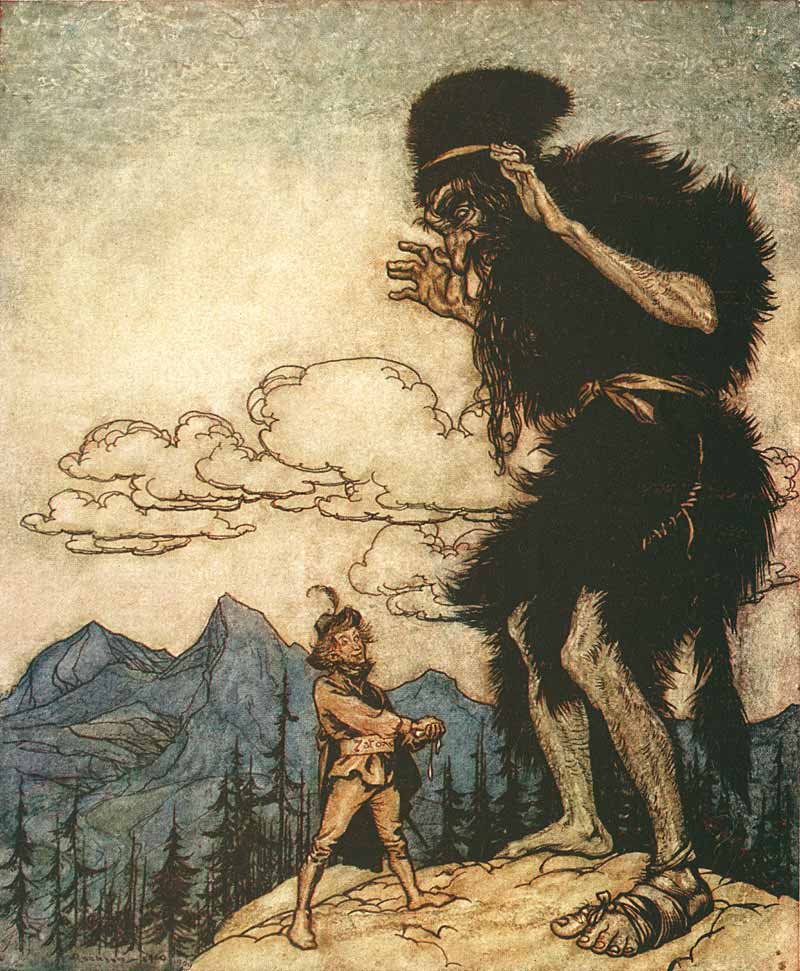Thursday, September 24, 2015
The Valiant Little Tailor: Grimms vs. Schonwerth
When the Schonwerth tales were released in English, one of the selling points of the collection was that you could compare a version of "The Valiant Little Tailor" with the Grimm story about a man who kills seven flies and tricks his enemies into fearing him using clever wordplay (or lying, depending on how you look at it).
The marketers of the Schonwerth collection were very quick to jump on how dark and violent his unedited tales were compared to the Grimms'. Of course it's not like the Grimm tales are all rainbows and pink flowers either, however, I do think the Schonwerth version of this story is darker overall. Although I'm confused...there may have been multiple versions of this tale in his collection. In this interview with Maria Tatar, (titled Down and Dirty Fairy Tales: How this rediscovered stash of darker-than-Grimm stories destroys our Prince Charming myths), she says,
"One example in this book is a version of the well-known story of “The Valiant Little Tailor,” the guy who kills seven flies with one blow. The Grimms’ version has the flies hovering over a sandwich that the fellow has made. In Schönwerth, the flies are hovering over a dung heap. So that gives you a sense of the raw energy of the stories and the way that Schönwerth decided he was going to tell it straight up, tell it like it was."
But in my copy, the story that is clearly the "Valiant Little Tailor" version, "The Tailor and the Giants," there are no flies at all, and no dung heap. The tailor just happens to come across a sash (by a well in a forest) that says "Seven with one stroke; who can match that?" and takes it; rather than the Grimms' tailor who sews the sash himself, making him seem a little more full of himself.
The episode where the tailor fools the Giant is similar in both versions-they both squeeze a piece of cheese to appear strong enough to squeeze water out of rock, and they both release a bird pretending they can throw a rock even farther than the Giant. Yet the Grimms' tailor had happened to find those objects before he met the Giant, whereas the Schonwerth tailor picks up the objects as he goes. The Grimms' hero appears to be just lucky, whereas the Schonwerth tailor is thinking on his feet and appears more clever. There is an episode in the Grimm story not found in Schonwerth, in which the tailor also pretends to help the Giant carry a tree.
There are other minor differences I won't go into, but just highlight the ones I find the most significant. In both stories, the tailor is eventually charged with killing troublesome giants. In Grimms, they appear to be two completely unrelated giants-the King has to show the tailor where they live, and he tricks the giants into getting into an argument and killing each other. Yet Schonwerth makes it clear that the tailor kills the very Giants that he had just stayed with, and he was able to do it because he already knew where they lived and their schedule. After cutting off their heads, he also cuts out their eyes and tongues as proof for the King.
Then, Grimms' tailor only has to secure a unicorn and a boar before being able to wed the princess. Schonwerth's hero is charged with killing seven Dragons that demanded daily human sacrifices, and a Serpent who would eat any humans that came near. Certainly more intimidating foes.
Then, in the middle of the tailor's slaying, he notices that the words on his sash have changed-now they tell him the secret to killing the rest of the Dragons. I like that element that the sash is a magical helper.
In both stories, the tailor wins the Princess that was his prize for his feats. She overhears him talking in his sleep about sewing, revealing that he was a tailor (a very lowly position at the time). The Princess tells the King she doesn't want a husband who was once a tailor. The Grimms' King promises to capture the tailor and ship him off across the world. The Schonwerth King was more violent-he arranged to place his new son in law at the front of an army in a doomed battle. But once again, the tailor looks down to see that the words on the sash have changed a third time, to say "You shall be the victor!" The tailor happened to come across a crucifix, and the sight of the "God of the Christians" fighting with the tailor's army caused the other army to flee in terror.
The Grimms' tailor just pretends to talk in his sleep again and threatens the King's servants who run away before shipping him off, so he stays King and nothing is said about the Princess' feelings changing towards him. The Schonwerth tailor returns to his wife who now respects him and they both lived long and happy lives.
Illustrations, in order: Arthur Rackham, H. J. Ford, Alexander Zick, Kay Nielsen
Subscribe to:
Post Comments (Atom)






Read the version in the Turnip Princess. That one has the dung heap (translated by Maria Tatar). Also, the tailor might not be a hero at the beginning, but he does kill seven flies with a sword... which is pretty nifty :)
ReplyDeleteOkay, there must be two different versions of the tale. I don't have the Turnip Princess book, just the one translated by Charlotte Wolf. I generally trust Maria Tatar as a valid source of fairy tale information! It would be really interesting to compare that tale to these two!
DeleteYes, what I am saying is, the one Tatar referred to (with the dung heap) is in the Turnip Princess. I assume Schönwerth probably collected several versions of the Valiant Tailor. Turnip Princess alone contains multiple versions of some of the tales.
Delete